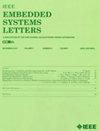在传感器印刷多层感知器训练过程中降低ADC前端成本
IF 2
4区 计算机科学
Q3 COMPUTER SCIENCE, HARDWARE & ARCHITECTURE
引用次数: 0
摘要
印刷电子(PEs)技术为计算需求提供了一种成本效益高、完全可定制的解决方案,超越了传统硅技术的能力,提供了诸如按需制造和保形、低成本硬件等优势。然而,pe的低分辨率制造导致了大的特征尺寸,这对集成像机器学习(ML)分类系统这样的复杂设计提出了挑战。目前的文献只优化了分类系统中的多层感知器(MLP)电路,而忽略了模数转换器(adc)的成本。印刷应用经常需要传感器上的处理,然而,虽然数字分类器已被广泛优化,但模数接口,特别是adc,在总面积和能耗方面占主导地位。在这封信中,我们的目标是数字印刷MLP分类器,我们提出每个MLP输入定制ADC的设计,其中包括最小化每个输入的不同表示数字,从而简化ADC的电路。在MLP训练中结合这种ADC优化,可以消除ADC水平和各自的比较器,同时仍然保持较高的分类准确性。我们的方法在不同的mlp中实现了11.2倍的ADC面积降低,精度下降不到5%。本文章由计算机程序翻译,如有差异,请以英文原文为准。
Reducing ADC Front-End Costs During Training of On-Sensor Printed Multilayer Perceptrons
Printed electronics (PEs) technology offers a cost-effective and fully-customizable solution to computational needs beyond the capabilities of traditional silicon technologies, offering advantages, such as on-demand manufacturing and conformal, low-cost hardware. However, the low-resolution fabrication of PEs, which results in large feature sizes, poses a challenge for integrating complex designs like those of machine learning (ML) classification systems. Current literature optimizes only the multilayer perceptron (MLP) circuit within the classification system, while the cost of analog-to-digital converters (ADCs) is overlooked. Printed applications frequently require on-sensor processing, yet while the digital classifier has been extensively optimized, the analog-to-digital interfacing, specifically the ADCs, dominates the total area and energy consumption. In this letter, we target digital printed MLP classifiers and we propose the design of customized ADCs per MLP’s input which involves minimizing the distinct represented numbers for each input, simplifying thus the ADC’s circuitry. Incorporating this ADC optimization in the MLP training, enables eliminating ADC levels and the respective comparators, while still maintaining high classification accuracy. Our approach achieves
$11.2\times $
lower ADC area for less than 5% accuracy drop across varying MLPs.
求助全文
通过发布文献求助,成功后即可免费获取论文全文。
去求助
来源期刊

IEEE Embedded Systems Letters
Engineering-Control and Systems Engineering
CiteScore
3.30
自引率
0.00%
发文量
65
期刊介绍:
The IEEE Embedded Systems Letters (ESL), provides a forum for rapid dissemination of latest technical advances in embedded systems and related areas in embedded software. The emphasis is on models, methods, and tools that ensure secure, correct, efficient and robust design of embedded systems and their applications.
 求助内容:
求助内容: 应助结果提醒方式:
应助结果提醒方式:


